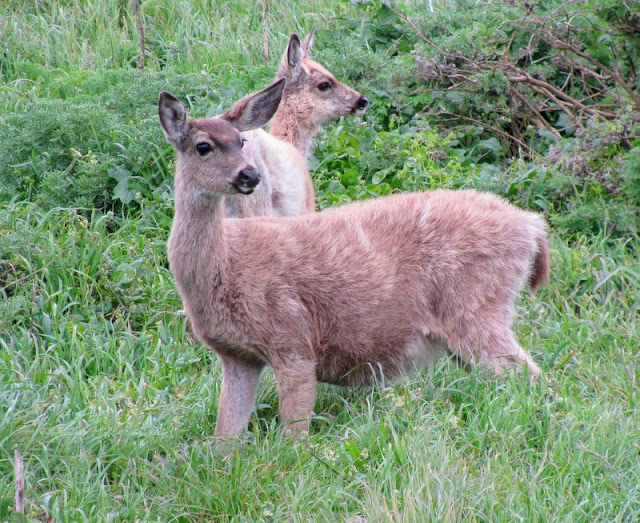 We had a marathon travel day planned, that started with an early-morning bike ride over the Golden Gate Bridge that was described in the last blog. But our day was too long to fit into one blog, so welcome back to the second half of our tourist day north of San Francisco! We ended that blog driving through the town of Sausalito. But we didn't linger long there because we had a date with more national treasures. We got good use out of our national park pass this afternoon. Even though this isn't a great weather day, it's supposed to be raining tomorrow. We wanted to see the Redwood trees at John Muir Woods while we were in the neighborhood.
We had a marathon travel day planned, that started with an early-morning bike ride over the Golden Gate Bridge that was described in the last blog. But our day was too long to fit into one blog, so welcome back to the second half of our tourist day north of San Francisco! We ended that blog driving through the town of Sausalito. But we didn't linger long there because we had a date with more national treasures. We got good use out of our national park pass this afternoon. Even though this isn't a great weather day, it's supposed to be raining tomorrow. We wanted to see the Redwood trees at John Muir Woods while we were in the neighborhood.Actually, it's not exactly in the neighborhood. While it's only 30 miles away, it takes over an hour of very focused driving to get to the woods high up in the mountains.
That winding road is the reason these trees are still around for us to enjoy. When the logging industry was cutting down 600-year-old redwoods to build houses in San Francisco, there was no way to get these giant logs off this mountain. It's hard to take a picture of a 200 foot tall tree, and you can barely see Mark standing at the base of this group.
We went to one of the ranger talks, and she explained that 80% of these trees will sprout up from another tree. They call those family circle trees. The other 20% will come up from seed. Those seeds are found in the tiny pine cones that these huge trees produce. It's amazing to us that such a big tree produces a pine cone about the size of a small olive. This is the size of one pine cone in Denisa's hand.
Even though we found some good-sized trees, we must have been over-awed by the sequoia trees we had seen several weeks ago. In comparison, these trees at Muir Woods seemed spindly to us.
Or perhaps it was the big crowds, or the fact that we had to stay on groomed trails separated from the trees by fences. So even though it was a beautiful stop, we weren't as inspired by our stop at Muir Woods as we expected.
But it was a lovely place to be wandering among some of the biggest trees in the world. The ranger explained that most of these trees are 500-600 years old, youngsters among some of the old-growth redwoods we should see later as we travel north from here.
We're taking the slow road home, along the winding Highway 1 that hugs the coast. Actually parts of Highway 1 are closed because of mud slides and crumbling roads due to the excess rain this spring. So we had some detours along more winding roads that made our trip even longer. We made a stop at Stinson Beach, where only the toughest tourists are out today in the cool and wet weather.
Our last stop of this long touring day was to Reyes Point National Seashore. In fact, we made it to the visitor's center just as they were closing at 5:00. But we grabbed a map and some fast advice from the ranger. We found that we are once again driving along the San Andreas fault, as we head down the road to the ocean. This is our view from above as we see the Reyes Point national sea shore for the first time.
We achieved that view from hiking straight up the .6 mile trail that leads to the lighthouse viewpoint. The wind was howling by this time, and we could look down to see the lighthouse that was built in 1870 to warn ships of the rocky shore line that surrounds this point.
We could have also walked down the 300 steps for a closer look at the lighthouse. But then we remembered that would also necessitate climbing back up those 300 steps.
So we opted for zooming in for a picture instead. Since it was closed to visitors for the day, it seemed like the next best thing to being there. Our perch on the hill is supposed to be a great place to watch for the migrating whales that follow this coast at this time of the year. According to the board at the visitor center, there were 63 gray whale sightings today, but none of them by us.
On the downhill walk back to the car, we got a foggier view of the national sea shore, but this time with some nice flowers in the foreground. This eleven-mile stretch of beach was designated a national sea shore to protect the marine life there. It's a treacherous stretch of beach, with high surf, dangerous rip currents, severe undertow, and very large "sneaker" waves that can be deadly. The description in the park brochure didn't make it sound like a friendly beach to visit.
It's interesting that the 45-minute drive from the visitor's center is along narrow country roads that pass by several ranches and dairy farms. While most of the park's land is protected as wilderness, we found that one-third is preserved as a "pastoral zone."
We thought these Holstein cows lined up at the gate for milking time looked very "pastoral." We weren't expecting milk cows to be our only wildlife sighting along the national sea shore.
But we did see a small group of deer on the hillside as we got closer to the lighthouse.
A closer photo shows that they are still wearing their thick winter coats in April. We can confirm that you need a thick coat for some visits here this month.
While we were this deep into the national park, we also drove the one-laned road towards Chimney Rock. We decided it was too cold and windy to make the hike to the point, but we couldn't resist a look at the seal overlook. Some of those odd-shaped "rocks" on the beach are moving.
Those "rocks" are actually a large group of elephant seals, huddled together as far away from the water as the hills would allow. There were a few swimming in the cold surf this evening, but most seemed to be very happy staying dry.
Even at this distance, we could zoom into the pile of seals to see that this group looked different than the other ones we have been seeing on the coast. These are elephant seals, with their longer snouts. It sounds like the guys are barking out insults to each other as we watched.
This evening on the coast turned cold and wet and windy on us, and we were getting weary from all our sight seeing. But Denisa wasn't too cold to stop and take a picture of a wild iris at the peak of its bloom. It didn't seem to mind the weather conditions at all.
We left the motor home before 8:00 this morning, and we didn't return until after 8:30 this evening. We had biked up and down hills in San Francisco; we had hiked through Redwood forests; and up and down hills at the beach. Who knew that this retirement journey was going to be so tiring? For some reason we don't expect anyone to feel sorry for us, and we are happy to be working so hard as we wander through God's wonders on another long day!
































0 Response to "Muir Woods and Point Reyes--More National Treasures!"
Post a Comment